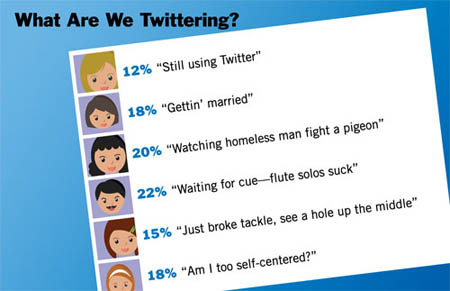At this time last year, Twitter was just a blip. The first academic study on microblogging wasn’t even finished collecting their data, and Facebook’s application platform was about to explode, dominating blog chatter. A year later, tracking “twitter” is more time-consuming and the consumers of the API are creating APIs, but we are still focused on the wrong metrics.

What are we Twittering? (source: The Onion)
On Friday, Larry Chiang posted yet another list of how to leverage Twitter for marketing purposes. On the surface, there’s nothing sinister about what he wrote. It echoes and augments what Ed Dale termed side-by-side communication, developing a shallow but trusted relationship with others so as to make one’s message better received. Chiang is specifically examining Twitter as a tool for founders of startup companies when offering the following tips:
- Don’t be afraid to Tweet above your head.
- Watch your Twitter ratios.
- Leverage what’s going on.
- Move your Twitter conversation(s) off-line.
- Migrate your real-world conversation to Twitter.
- Time your tweets.
- Pre-write some of your material.
- Work the Twitter Room for product development.
My problem with this approach is that is undercuts one of the things that makes Twitter work: authenticity.
I am glad that marketers are embracing Twitter because, unlike other channels, each of us has near-complete control over what we see. A spammer can only gain a foothold in our tweet streams if we allow that message in by following him, and we can stop such messages at any point afterward simply by unfollowing. There are a few basic tips to identify a spammer—most notably an insanely imbalanced following-to-follower ratio—but one often overlooked one is authentic posting. Do the tweets reek of self-promotion?
For a channel dedicated to spreading millions of short posts daily about personal minutiae, sensitivity to self-promotion in Twitter may seem like an oxymoron. However, there is a difference between answering the core question—”What are you doing?”—and gaming the system. It’s a difference that is noticeable on some level. As spammers inevitably adapt to the technological and cultural constraints in Twitter, an “authenticity radar” will be used by members more and more to shut off unwanted messages.
The most interesting aspect of Chiang’s list is its dual nature when viewed in the lens of authenticity. It can be interpreted as inherently manipulative and false, a guide to inauthentic behavior. It can also be viewed as an encouragement, appeasing concerns about participation and transparency that support authentic posts. On my pessimistic days, the term marketing invokes only the former.
There is no right way to use Twitter (one of its many beauties). However, I think we as producers and consumers of content benefit greatly by reducing the list to one core mantra: Be Authentic.